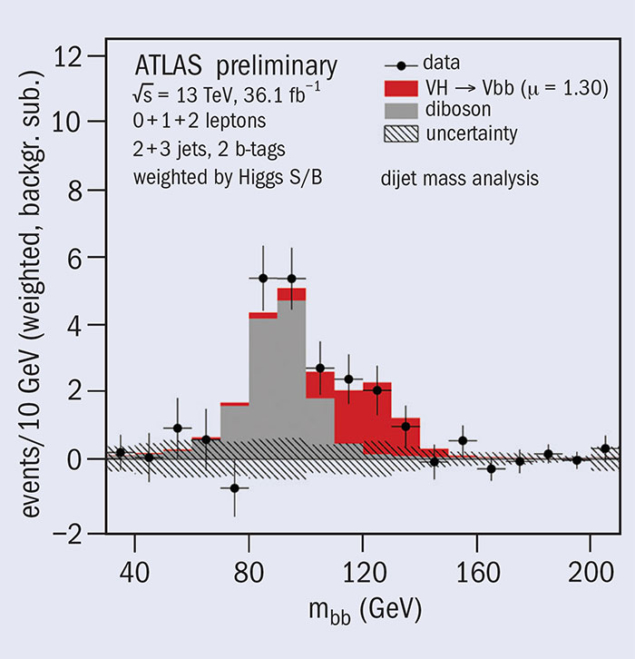
Five years ago, the ATLAS and CMS collaborations at the LHC announced the discovery of a new particle with properties consistent with those of a Standard Model Higgs boson. Since then, based on proton–proton collision data collected at energies of 7 and 8 TeV during LHC Run 1 and at 13 TeV during Run 2, many measurements have confirmed this hypothesis. Several decay modes of the Higgs boson have been observed, but the dominant decay into pairs of b quarks, which is expected to contribute at a level of 58%, had up to now escaped detection – largely due to the difficulty in observing this decay mode at a hadron collider.
On 6 July, at the European Physical Society conference in Venice, the ATLAS collaboration announced that they had found evidence for H → bb, representing an immense analysis achievement. By far the largest source of Higgs bosons is their production via gluon fusion, gg → H → bb, but this is overwhelmed by the huge background of bb events, which are produced at a rate 10 million times higher. The associated production of a Higgs with a W or Z vector boson (jointly denoted V) offers the most sensitive alternative, despite having a production rate roughly 20 times lower than H→ bb, because the vector bosons are detected via their decay to leptons and therefore allow efficient triggering and background rejection. Nevertheless, the signal remains orders of magnitude smaller than the backgrounds, which arise from the associated production of vector bosons with jets and from top-quark production.
To find evidence for the H → bb decay in the VH production channel, it is necessary to use detailed information on the properties of the decay products. The jets arising from b quarks contain b hadrons, whose long lifetime can be used in sophisticated b-tagging algorithms to discriminate them from jets originating from the fragmentation of gluons or other quark species. These algorithms have benefitted significantly from the new innermost pixel layer installed in ATLAS before Run 2. The kinematic properties of the decay products can also be used to enhance the signal-over-background ratio. The property with the most discriminatory power is the invariant mass of the two-b-jet system, which for the signal accumulates at the mass of the Higgs boson (see figure). To increase the sensitivity of the analysis, this mass is used together with several other kinematic variables as input to a multivariate analysis.
Based on data collected during the first two years of LHC Run 2 in 2015 and 2016, evidence for the H → bb decay is obtained at the level of 3.5σ, slightly increased to 3.6σ after combination with the Run 1 results (compared to an expected significance of 4σ). The measured signal yield is in agreement with the Standard Model expectation, within an uncertainty of 30%. The associated VZ production, with Z → bb, allows for a powerful cross-check of the analysis, as the final states are very similar except for the location of the two-b-jet mass peak (see figure); VZ production is observed with a significance of 5.8σ in the Run 2 data, in agreement with the Standard Model prediction.
This analysis opens a way to study about 90% of the Higgs boson decays expected in the Standard Model, which is a sharp increase from the approximately 30% observed previously. With much more data expected by the end of Run 2 in 2018, a definitive 5σ observation of the H → bb decay may be in sight, with the increased precision providing new opportunities to challenge the Standard Model.
Further reading
ATLAS Collaboration 2015 JHEP 01 069.
ATLAS Collaboration 2016 ATL-PHYS-PUB-2016-012.
ATLAS Collaboration 2017 ATLAS-CONF-2017-041.





